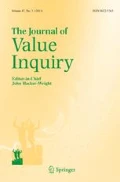Notes
See Richard Kraut, What is Good and Why (Cambridge, Mass.: Harvard University Press, 2007).
Ibid.
See Connie Rosati, “Relational Good and the Multiplicity Problem,” Philosophical Issues, 19, Metaethics (2009).
Ibid.
See Kraut, op. cit., p. 132.
See Rosati, “Relational Good and the Multiplicity Problem,” p. 213.
Kraut, op. cit., p. 132.
Rosati, “Relational Good and the Multiplicity Problem,” pp. 219-220.
Kraut, op. cit., p. 94.
See Kraut, op. cit., p. 149.
See Peter Railton, “Facts and Values,” Philosophical Topics 14 (1986); see also Kraut, op. cit.; Toni Rønnow-Rasmussen, “Analysing Personal Value,” Journal of Ethics 11, no. 1 (2007); and Connie Rosati, “Objectivism and Relational Good,” Social Philosophy & Policy 25 (2008).
See Michael Ruse, “Evolutionary Biology and Teleological Thinking,” in André Ariew, Robert Cummins, and Mark Perlman, eds., Functions: New Essays in the Philosophy of Psychology and Biology (Oxford: Oxford University Press, 2002), p. 35.
See Larry Wright, “Functions,” The Philosophical Review, vol. 82, no. 2 (1973) and Robert Cummins, “Functional Analysis,” The Journal of Philosophy, vol. 72, no. 20 (1975).
See C.F. Craver, “Role Functions, Mechanisms, and Hierarchy,” Philosophy of Science, 14 (2001).
See John Bigelow and Robert Pargetter, “Functions,” Journal of Philosophy, 84 (1987); see also Ruth Garret Millikan, “In Defense of Proper Functions,” Philosophy of Science, 56 (1989); Paul E. Griffiths, “Adaptive Explanation and the Concept of a Vestige,” in Paul E. Griffith, ed., Trees of Life (Dordrecht: Kluwer, 1993); and Philip Kitcher, “Function and Design,” Midwest Studies in Philosophy, 18 (1993).
See Wright, op. cit.; see also Karen Neander, “Function as Selected Effects: The Conceptual Analyst’s Defense,” Philosophy of Science, 58 (1991); and Ruth Garrett Millikan, Language, Thought, and Other Biological Categories (Cambridge, Mass.: MIT Press, 1984).
Christopher Boorse, “A Rebuttal on Functions,” in André Ariew, Robert Cummins, and Mark Perlman, eds., Functions: New Essays in the Philosophy of Psychology and Biology (Oxford: Oxford University Press, 2002).
Allan Gibbard, Wise Choices, Apt Feelings (Cambridge, Mass.: Harvard University Press, 1990), p. 29.
I would like to thank Russ Shafer-Landau, Robert Streiffer, Daniel M. Hausman, Gina Schouten, Thomas Magnell, Editor-in-Chief of the Journal of Value Inquiry, and an anonymous referee for reading earlier drafts of this article and providing useful comments. I am indebted to John Basl for fruitful conversations on many issues explored in the article, particularly on issues related to functions. I am grateful to Elliott Sober for helping me think through some of the issues related to group selection. I first began thinking about the central ideas discussed in this article during a seminar conducted by Russ Shafer-Landau in the spring of 2008. I thank him and all the participants in that seminar for rich and insightful discussion.
Author information
Authors and Affiliations
Corresponding author
Rights and permissions
About this article
Cite this article
Behrends, J. A New Argument for the Multiplicity of the Good-for Relation. J Value Inquiry 45, 121–133 (2011). https://doi.org/10.1007/s10790-011-9273-1
Published:
Issue Date:
DOI: https://doi.org/10.1007/s10790-011-9273-1

